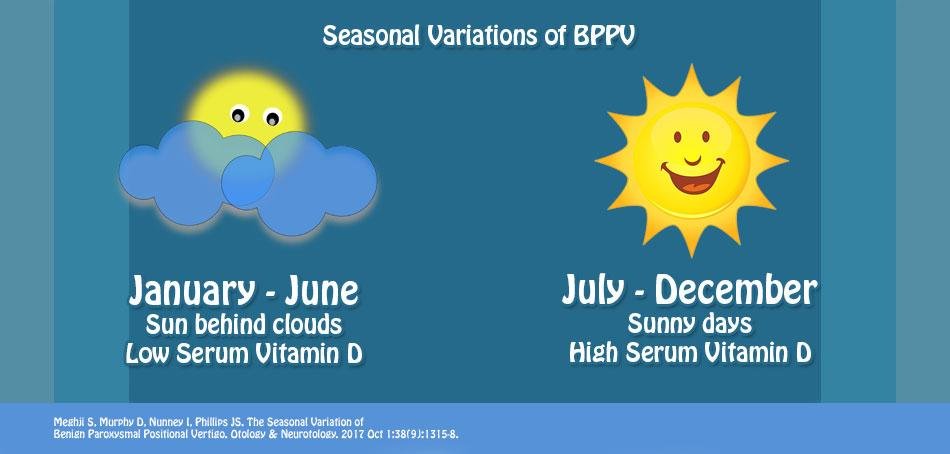
Benign paroxysmal positional vertigo (BPPV) is an inner ear disorder characterized by brief attacks of vertigo and associated nystagmus, precipitated by certain changes in head position with respect to gravity due to dislodged otoconia debris within the semicircular canals.
It is the most common cause of dizziness in ENT patients, affecting 40% of them and it is the most common cause of vertigo arising from labyrinthine dysfunction.
BPPV has got an annual incidence of 0.1%, which increases with age and the maximum incidence is at 6th decade of life. The lifetime prevalence of BPPV is 2.4%.
Benign Paroxysmal Positional Vertigo occurs both in adults and children. Females are affected more commonly than males.
Causes of Benign Paroxysmal Positional Vertigo
Various conditions are associated with triggering of a BPPV attack. Some of them include head trauma, middle ear infection, viral labyrinthitis, vestibular neuritis, ear surgery, etc. But in 50% of cases, the exact triggering factor is unknown.
In 1969 Schucknecht proposed the theory of cupulolithiasis and in 1979, Hall proposed the concept of canalolithiasis to explain the pathophysiological process of Benign Paroxysmal Positional Vertigo.
Vitamin D, Serum Calcium and Bone mineral density in BPPV
Calcium is the main component of Otoconia (balancing crystals inside inner ear), and Vitamin D is required for its regulation. It is observed that serum vitamin D levels are lower and the prevalence of vitamin D deficiency is higher among BPPV patients when compared with other normal controls.
Normally the major source of Vitamin D for the body is from the UV-B radiations in sunlight falling on the skin. In the Northern hemisphere, at latitudes greater than 40°N this sunlight-induced Vitamin D synthesis becomes effective only in April and reaches its highest concentration in September.
Low levels of vitamin D is associated with low bone mass and has a positive correlation with BPPV. In a recent study, bone mineral density score was found to be less in both women and men with idiopathic BPPV. Various other studies have also shown a positive correlation of BPPV with osteoporosis, osteopenia, and bone mass density which all are due to altered calcium metabolism.
Seasonal variation of BPPV
Much human illness shows seasonal variations due to changes in atmospheric or weather conditions.
In a previous study conducted in Boston, Massachusetts, it was observed that one’s serum vitamin D level falls during winter with the lowest values in early spring (March-May). The highest number of BPPV clinic visits in Boston were observed during these early spring.

A similar study conducted recently (2017) by Meghji in the UK concluded that serum vitamin D levels reach its lowest level in May and the highest levels in September. 30–40% of the UK population were found to have a serum Vitamin D concentration of<25nmol/L in the winter compared with only 2 to 13% in the summer. The BPPV clinic visits have also shown a positive correlation with these levels.
In another study, it was observed that BPPV group exhibited elevated values for HSV1 and adenovirus in March and May. Herpes zoster, adenovirus, and influenza virus levels were elevated in April. HSV1 levels were higher in June, and both HSV1 and CMV levels were elevated in September. These viral infections might promote BPPV attacks due to the development of vestibulopathy via viral neurolabyrinthitis.
Some studies have shown that in certain localities where climate variations are markedly evident, the highest number of BPPV patient visit to vestibular clinics occurs in cold seasons. This may be due to pathological process of rhinosinusitis or reactivation of the neurotropic virus in cold climates.
Role of Vitamin D in treatment of BPPV
Spontaneous recovery can occur in up to 50% of BPPV patients over many months to years. But opting for this is associated with poor quality of life. Active treatment with two successive canal repositioning maneuvers is associated with 90% resolution.
The beneficial effect of vitamin D therapy on severity of BPPV may be due to direct effect of vitamin D on the vestibular system or indirect effect of vitamin D, on muscle strength, fall, balance and musculoskeletal system.
Conclusion
BPPV is a common cause of vertigo with a high recurrence rate and having a significant negative impact on patient’s quality of life.
Though recent studies could establish that BPPV demonstrates seasonal variability with a higher number of patient visits during the spring season, when serum vitamin D levels are at the lowest levels, only little is known about the effects of vitamin D on mineralization of otoconia.
Vestibular rehabilitation with concomitant identification and management of low Vitamin D levels can improve outcomes in recurrent Benign Paroxysmal Positional Vertigo.
References
- Schuknecht HF. Cupulolithiasis. Arch Otolaryngol 1969;90:765-778.
- Hall SF, Ruby RR, McClure JA. The mechanics of benign paroxysmal vertigo. J Otolaryngol 1979;8:151-158.
Jeong SH, Choi SH, Kim JY, Koo JW, Kim HJ, Kim JS. Osteopenia and osteoporosis in idiopathic benign positional vertigo. Neurology. 2009 24;72(12):1069-76. - Sheikhzadeh M, Lotfi Y, Mousavi A, Heidari B, Monadi M, Bakhshi E. Influence of supplemental vitamin D on intensity of benign paroxysmal positional vertigo: A longitudinal clinical study. Caspian J Intern Med 2016;7:93–8.
- Saeed BMN, Omari AF. Climatic variations and benign paroxysmal positional vertigo. J Otol 2016;11:33–7.
- Hanci D, Ulusoy S, Muluk NB, Cingi C. Do viral infections have a role in benign paroxysmal positional vertigo?. B-ENT. 2014 Dec;11(3):211-8.
- Whitman GT, Baloh RW. Seasonality of benign paroxysmal positional vertigo. JAMA Otolaryngology–Head & Neck Surgery. 2015 Feb 1;141(2):188-9.